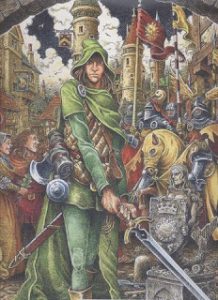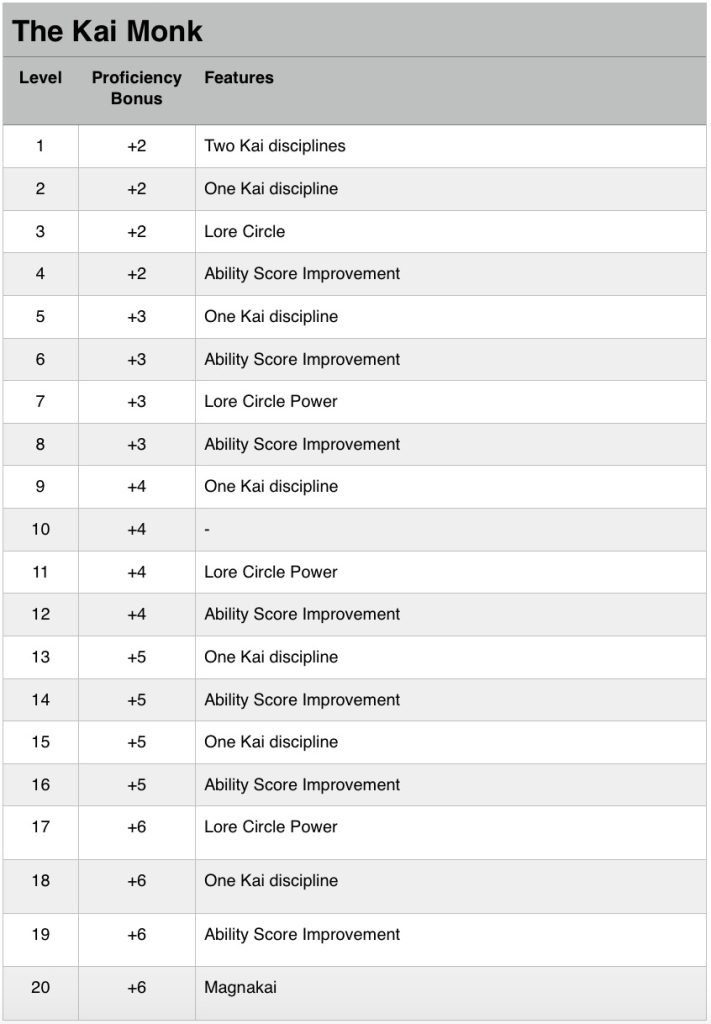Kai Monks of Sommerlund for 5th edition

The Kai Monks of Sommerlund
The Kai monks of Sommerlund first appeared in the Lone Wolf Choose Your Own Adventure game book, “Flight from the Dark” by Joe Dever and Gary Chalk, published in 1984. Until that time, Choose Your Own Adventure novels told you who you were and what you could do, allowing you to choose which road to follow, what tunnel to explore, or whether to face a monster. What made the Lone Wolf series a fan-favorite was that you could create your own character, choose from a list of interesting powers, select your starting gear, carry items from book to book, and fight monsters using a combat system. Not only could you choose from ten different powers (called disciplines), you gained new powers for each book in the series you completed; effectively leveling up after each book. The Lone Wolf series allowed us to play a solo roleplaying game long before video games became the norm.
In the Lone Wolf series, you play a Kai monk named, of course, Lone Wolf. You are the only survivor of the Kai monastery after it is destroyed and all of the other monks are murdered. I think of the Kai monks as the fantasy equivalent of Jedi Knights; they are peacekeepers, diplomats and explorers, with a range of skills and powers normal citizens can only dream of. Kai monks are trained in physical combat, psychic powers such as telepathy and telekinesis, healing, diplomacy, and more. In the first book, you are trained in 5 of the 10 Kai disciplines and the choices gave you additional options during your adventure. Say you select Animal Kinship as one of your powers. Your choices in a section where you are facing a bear may include running, fighting, or using your Animal Kinship powers, with each choice sending you to a different section. If you didn’t choose Animal Kinship, you were limited to fighting or running.
 When you completed a novel, you were allowed to choose an additional discipline to use during your next adventure, as well as carry over equipment, magic items, and your ability scores (Combat Skill and Endurance Points). By the time you reached book 6, “The Kingdoms of Terror”, you mastered all 10 of the basic disciplines, so you begin training in the advanced techniques called MagnaKai disciplines. The latter novels would take into account your basic skills in every discipline, while granting options for using the advanced disciplines in more difficult situations.
When you completed a novel, you were allowed to choose an additional discipline to use during your next adventure, as well as carry over equipment, magic items, and your ability scores (Combat Skill and Endurance Points). By the time you reached book 6, “The Kingdoms of Terror”, you mastered all 10 of the basic disciplines, so you begin training in the advanced techniques called MagnaKai disciplines. The latter novels would take into account your basic skills in every discipline, while granting options for using the advanced disciplines in more difficult situations.
These books also introduced the concept of Lore Circles: areas of study that, when mastered, would increase your Combat Skill and Endurance points. Starting in book 13, “The Plague Lords of Ruel”, you learn even more powerful versions, called Grand Master disciplines on your way to becoming the first Kai Supreme Master after book 20.
The Lone Wolf universe is still alive and well 30 years later. You can download the entire 28 book series, including its spin-offs, formatted for ereaders at Project Aon for free! There are also iOS and Android apps available for your smartphones and tablets. Crowd-funded projects for a spin-off series, a board game, an adventure game and more have been successfully funded, continuing to bring the world of Aon and the lands of Magnamund to our gaming tables.
Why Convert the Kai Monks to 5th edition?
Aside from being a huge fan of the series, the Kai monks are ideal for many fantasy worlds. Their powers and skills cover a wide range of abilities, making them the renaissance men and women of fantasy. In the early books, their Kai disciplines place them on a similar level as other PC classes, and by book 6 they are both versatile and effective. By the time Lone Wolf completes book 12, he possesses an incredible amount of power in relation to the core D&D classes, and from book 13 on he’s beyond even Epic tiers of play. Does that mean the Kai monks are unable to be converted to 5th edition? Not at all. Creating a version of the Kai monks that can be played alongside the core classes was a challenge, no doubt, but the concept of Lore Circles allowed for archetypes that parallel other classes and allowed specialization even among this jack-0f-all-trades class. Creating the feel of the Kai monks was far more important than duplicating their powers point-for-point.
Playtesting
We’re always looking for playtesters for our races, classes, archetypes and other designs here at Tribality. Wizards had the benefit of 175,000 playtesters over 2 years to get their ideas to the table; clearly we don’t have that luxury. Each of our builds are as balanced as we can design with a small playtest group and decades (over a century, maybe, I haven’t done the math) of gaming XP, and we are always excited to hear when players get these ideas on the table and provide us with constructive ways to make them better.
Kai Monks and Party Composition
Kai monks can fill numerous roles within a party. Circle of Fire monks are frontline combatants at home in the wilderness. Though not as effective in their weapon or wilderness skills as fighters and rangers, they can go toe-to-toe with most combatants and their other Kai disciplines compliment their combat skills in a way rangers and fighters may envy. Circle of Light monks are solid healers and often have animal companions to aid them. As with other Circles, they are not as varied or powerful in their healing spells as a cleric or druid, but their versatility makes up for that. Circle of Solaris monks are expert infiltrators, able to sense danger and adapt their bodies and minds to both natural surroundings and civilized societies. Without the sneak attack feature of the rogue or spell versatility of the bard, Solaris monks aren’t as powerful in combat, but their access to spells outside the rogue’s purview, and unique combat options offered by their other disciplines, make them powerful spies and diplomats. Circle of the Spirit monks gain psychic attacks and can protect themselves from mental, physical, and elemental assaults. While unable to throw fireballs or call lightning from the sky, Spirit monks can protect themselves and their companions from a variety of dangers and engage opponents in melee while simultaneously attacking their minds.
Kai monks that reach the level of Magnakai receive training in all 8 of the basic Kai disciplines, giving them a strong foundation for any conflict in addition to the more specialized abilities granted by their Lore Circle.
 Though Kai monks can be used alongside the core classes in 5th edition, another way to play is to have a party of 3-4 Kai monks performing missions for the Monastery of the New Kai Order. With each PC taking a different Lore Circle, the party should have the skills and spells necessary to face almost any situation.
Though Kai monks can be used alongside the core classes in 5th edition, another way to play is to have a party of 3-4 Kai monks performing missions for the Monastery of the New Kai Order. With each PC taking a different Lore Circle, the party should have the skills and spells necessary to face almost any situation.
Having said that, Kai monks aren’t the only class available to adventurers in Magnamund. Rangers, fighters, and rogues can be found among many of the NPCs Lone Wolf encounters, as well as wizards (Brotherhood of the Crystal Star), evil druids (Cenerese), good druids (Herbalish), alchemists, and even eldritch knights (warrior-mages of Dessi). For more information about the lands, kingdoms, monsters, and people of Magnamund, download the “Magnamund Companion” PDF from Project Aon for free.
Class Features
As a Kai monk, you gain the following class features.
Hit Points
Hit Dice: d8
Hit Points at 1st Level: 8 + Con mod
Hit Points at Higher Levels: d8 (5) + Con Mod
Proficiencies
Armor: Light armor, shields
Weapons: Simple weapons
Tools: None. Kai monks gain tool proficiencies only through their background and disciplines.
Saving Throws: Dexterity and Charisma
Skills: None. Kai monks gain skill proficiencies only through their background and disciplines.
Equipment
You start with the following equipment, in addition to the equipment granted by your background:
- (a) light crossbow and 20 bolts or (b) any simple weapon or (c) any martial weapon (if proficient)
- (a) leather armor or (b) chain shirt (if proficient)
- (a) scholar’s pack or (b) explorer’s pack
- (a) any one tool kit or (b) healer’s kit
- any simple weapon
Kai Disciplines
At 1st level, choose 2 of the following Kai disciplines. At 2nd, 5th, 9th, 13th, 15th and 18th levels, choose an additional discipline.
All Kai monk spells gained through disciplines are psychic in nature, similar to the Ki-powered spells of standard monks, and therefor require no material, verbal or somatic components. Wisdom is a Kai monk’s ability score for casting spells and the DCs of their spells equals 8 + Proficiency bonus + Wisdom modifier.
At 10th level you gain an additional power whether or not you are a member of the circle associated with your disciplines (see Lore Circles below).
- Animal Kinship: Kai masters believe that allies can be found anywhere, including the natural world. Your teachers have taught you to read the body language, and even the minds, of natural beasts. You gain proficiency with Animal Handling checks. You may cast speak with animals at will, animal messenger as a ritual, and animal friendship once per day. At 10th level, you may cast dominate beast as a 4th level spell once per day.
- Camouflage: Kai monks must travel far and wide, learning about and blending into other cultures as well as the natural environment. You gain proficiency with Stealth checks and Disguise kits. At 10th level, you may cast tongues once per day with a Range of self. [Note: Camouflage incorporates the linguistic skills originally found under the Tracking/Pathmanship disciplines from the original books.]
- Healing: Kai monks travel in search of knowledge and to help those in need. The world is dangerous and the presence of a Kai monk in a small village can mean the difference between life and death for those who live there. You gain the Healer feat, and proficiency with Medicine checks and Herbalism kits [If you are using the optional rules for the Healer feat, you gain the Advanced Healer feat instead]. In addition, you may cast detect poison and disease as a ritual and cure wounds as a 1st level spell once per short rest. At 10th level, you may cast cure wounds as a 4th level spell once per short rest.
- Hunting: Woodcraft is a crucial skill in the lands of Magnamund, whether you are finding food, avoiding enemies, or tracking giaks. You gain proficiency with Nature checks, and with either Perception or Survival checks (your choice), as well as with longbows and heavy crossbows. At 10th level, you gain darkvision to a range of 30 feet. If you already possess darkvision, its effective distance increases by 30 feet. [Note: The Hunting discipline combines many of the abilities of the Hunting and Tracking disciplines from the original books.]
- Mind Over Matter: The mastery of telekinesis requires subtle perception and intense concentration. Kai masters train their students to master skills requiring manual dexterity as a gateway to training the mind. You gain proficiency with Lockpicks and Sleight of Hand checks. You also gain the mage hand cantrip and the arcane trickster class feature Mage Hand Legerdemain (though you do not gain the ability to control the hand with a bonus action). At 10th level, you may cast telekinesis once per day with a duration of concentration, 1 minute.
- Psychic Combat: The Darklords of Helgedad manipulate the minds of the weak in ways that terrify their victims and lay waste to their enemies. Kai masters teach techniques for protecting their minds against assault as well as turning the tide of mental battles against the Darklords’ minions. You gain the mind blast cantrip. In addition, you gain advantage on saving throws against psychic damage and resistance to psychic damage. At 10th level, you may use your reaction to gain advantage on any Intelligence, Wisdom or Charisma saving throw. You may use this ability after you roll your saving throw but before the results are determined. You cannot use this ability again until you take a short rest. If you follow the Circle of the Spirit and already possess this feature, you may use this ability twice before taking a short rest. [Note: Psychic Combat combines the Mindshield and Mindblast disciplines from the original books.]
- Sixth Sense: Kai masters have learned to tap into the ebb and flow of nature, reading the inertia of temporal events and sensing the presence of unusual energies and humanoid emotions. You gain proficiency with Insight and Investigation checks. You may cast detect magic and detect good and evil each once per short rest. At 10th level, you gain advantage on Initiative checks.
- Weaponmastery: To Kai masters, combat training involves far more than weapon superiority; it means examining the history of warfare, tactics, strategy, and how to inspire allies instead of demanding obedience. You gain proficiency with History checks and either Acrobatics or Athletics checks (your choice), as well as with any 2 martial weapons and medium armor. At 10th level, you can attack twice, instead of once, whenever you take the Attack action on your turn.
Lore Circles
At 3rd level, select one of the following four Lore Circles of the Magnakai. Each circle focuses on one school of Kai philosophy.
To choose a circle, you must possess the disciplines associated with that circle. You gain additional Lore Circle abilities at 7th, 11th, and 17th levels.
Circle of Fire
Kai drawn to the Circle of Fire see the physical world more clearly than other Kai. They are practical in their daily lives and train to live with and protect the people who live off the land. You must have the Hunting and Weaponmastery disciplines to choose this circle.
At 3rd level, you gain the benefits of the ranger class feature Natural Explorer and may choose one favored terrain. In addition, you may select one fighting style from the list of fighting styles available to fighters.
At 7th level, you may cast pass without trace once per short rest. You also gain the ranger class feature Land’s Stride.
At 11th level, you gain proficiency with all martial weapons and may select a second favored terrain.
At 17th level, you may use a bonus action to gain blindsight to a range of 30 feet until the beginning of your next turn. This ability utilizes all of your available senses. If you are both blind and deaf, the range of your blindsight is decreased to 10 feet as you rely only on your senses of smell and touch, enhanced by your Kai-trained psychic abilities.
Circle of Light
Kai drawn to the Circle of Light are more empathic than their colleagues, gaining powerful healing skills and a deep bond with the natural world. You must have the Animal Kinship and Healing disciplines to choose this circle.
At 3rd level, you gain the spare the dying cantrip and may cast animal friendship once per day as a 2nd level spells, and cure wounds once per short rest as a 2nd level spell.
At 7th level, you may cast animal friendship and cure wounds as 3rd level spells and may cast lesser restoration or protection from poison in place of one use of cure wounds. You also gain the Mounted Combat feat.
At 11th level, you may cast cure wounds as a 4th level spell twice per short rest and beast sense as a ritual.
At 17th level, you gain advantage on social skill checks involving beasts, dragons, fey, and monstrosities. You may cast cure wounds as a 5th level spell twice per short rest, heal as a 6th level spell once per week, and detect poison and disease at will.
Circle of Solaris
Kai drawn to the Circle of Solaris are natural infiltrators. You can see beyond the bounds of the physical world and into the minds of others. You are able to blend into any natural or civilized environment, duplicating languages and customs like a native. You must have the Camouflage and Sixth Sense disciplines to choose this circle.
At 3rd level, you double any proficiency modifier you are allowed when creating a disguise or mimicking a voice, sound, or accent. You gain two new languages, may cast comprehend languages as a ritual and detect thoughts once per day.
At 7th level, you may cast augury as a ritual, see invisibility once per short rest and disguise self once per day.
At 11th level, you gain the ranger class feature Hide in Plain Sight. You may cast clairvoyance once per day and detect thoughts once per short rest. You also gain advantage on Dexterity saving throws against effects you can see, such as traps and spells.
At 17th level, you may alter your appearance at will, as if under the “change appearance” effects of the alter self spell. You may cast tongues at will with a range of self. You may cast detect magic and detect good and evil each twice per short rest, and both astral projection and true seeing once per day.
Circle of the Spirit
Kai drawn to the Circle of Spirit forge their minds into powerful weapons against the dark forces of Helgedad. Once these powers are unlocked, Kai monks learn to not only manipulate objects with their mind, they learn to guard themselves against harmful environmental effects through both psychokinetic power and mental discipline. You can protect yourself from physical, psychic, and elemental attacks, assault the minds and bodies of your opponents simultaneously, and shield your allies from mental assault. You must have the Mind Over Matter and Psychic Combat disciplines to choose this circle.
At 3rd level, you may cast shield once per short rest. You may use your reaction to cast shield on yourself, or any target within 30 feet of you that you can see. You may also use your reaction to gain advantage on any Intelligence, Wisdom or Charisma saving throw once per short rest. You may use this ability after you roll your saving throw but before the results are determined. You may cast protection from energy once per short rest with a range of self.
At 7th level, when you take an action to cast mind blast, you may make an attack as a bonus action. You may cast protection from energy twice per short rest with a range of self.
At 11th level, you gain proficiency with Wisdom or Intelligence saves (your choice). When you cast protection from energy you may choose two energy types and gain resistance to both energy types with the same casting. You may cast shield twice per short rest.
At 17th level, creatures make saves against your mind blast cantrip at disadvantage. When you cast protection from energy you become immune to two energy types instead of resistant. You may use your reaction to grant advantage on any Intelligence, Wisdom, or Charisma saving throw to an ally you can see instead of to yourself.
Ability Score Improvement
When you reach 4th level, and again at 6th, 8th, 12th, 14th, 16th and 19th level, you can increase one ability score of your choice by 2, or you can increase two ability scores of your choice by 1. As normal, you can’t increase an ability score above 20 using this feature.
Magnakai
At 20th level, you have reached the rank of Magnakai. One ability score of your choice increases by 2 and all other ability scores increase by 1. Unlike normal ability score increases, you may increase ability scores above 20 with this feature, to a maximum of 22.
New Cantrip
Mind Blast
Enchantment cantrip
Casting Time: 1 action
Range: 10 feet
Components: S
Duration: Instantaneous
A blast of psychic energy wracks your target’s mind, dealing damage and distracting them. The target must make a Wisdom saving throw or take 1d8 psychic damage and be unable to take reactions until the beginning of their next turn. The spell’s damage increases by 1d8 when you reach 5th (2d8), 11th (3d8) and 17th (4d8).
Backgrounds
Though Kai monks gain no core languages, tool proficiencies, or class skills outside of those they gain through studying Kai disciplines, students come to the monastery from a wide range of backgrounds. These backgrounds flavor each monk’s personality and skill set, allowing every member to add their own knowledge and history to your adventures.
Kai monks raised in the monastery from a young age possess one of the following backgrounds depending on their educational interests or manual skills. Some either find themselves at the monastery’s doorstep or are brought there by authorities after living on their own: Acolyte, Guild Artisan, Entertainer, Sage, or Urchin.
Some Kai monks come to the monastery in their late teens or early twenties, after spending some years in an outside apprenticeship or perhaps after a traumatic incident, such as the death of family or friends. These students can come from any background, though Folk Hero, Guild Artisan, Hermit, Noble, Outlander, Sailor, and Soldier are common.
Though rare, some Kai monks are given the choice of joining the monastery or spending time in jail. The youngest children of some nobles may be given the choice of joining the Kai ranks, either to force responsibility on them, or as an alternative to a life with little political power. These rare Kai may come from the Charlatan, Criminal, Noble, or Urchin backgrounds, or any background in which they’ve either committed a crime or chose to make a serious change in life.




